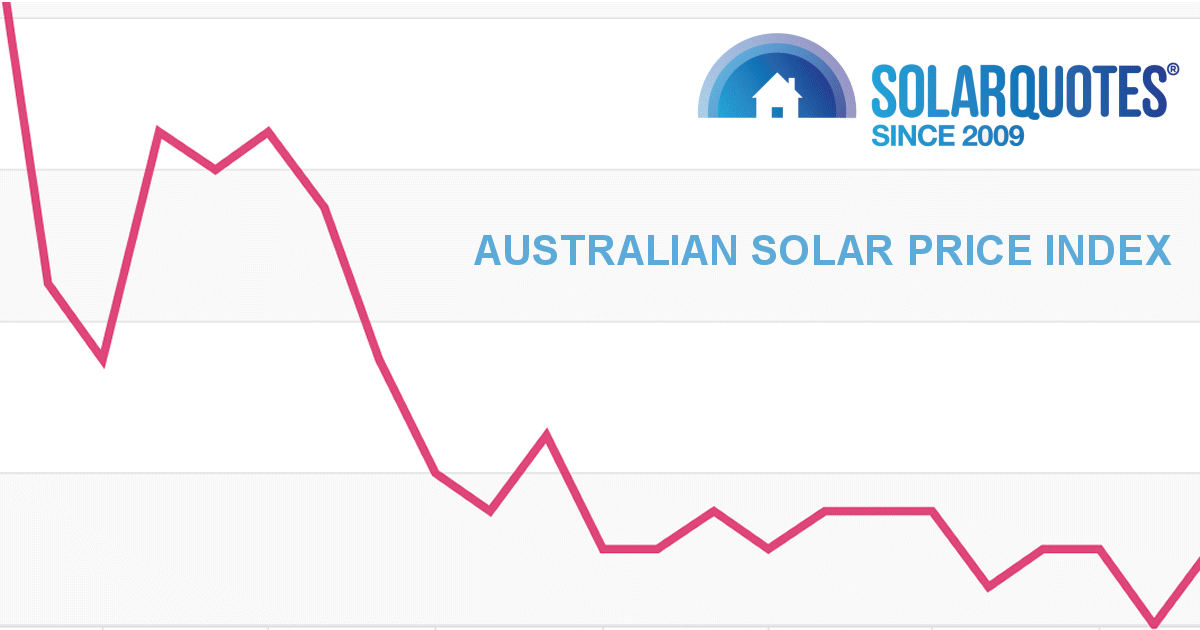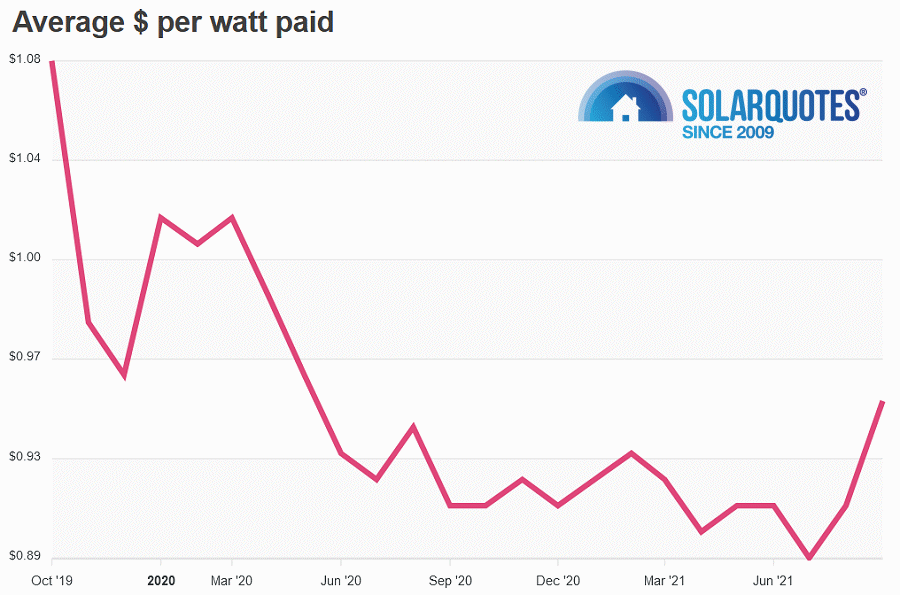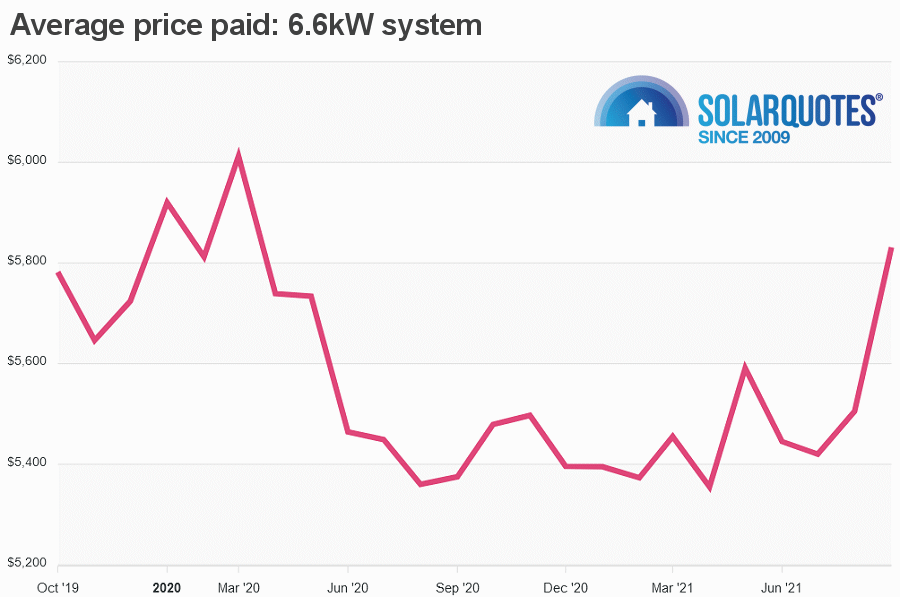
Australians in some states were paying more for solar power systems in September 2021, but still getting a bargain given the benefits solar energy brings.
Here’s how things looked for September compared to August, and also September last year. The average cost per watt is for fully installed systems (all system capacities) after all rebates and subsidies.
| State | Cost per watt (September 2021) |
Cost per watt (August 2021) |
Cost per watt (September 2020) |
| QLD | $0.89 | $0.89 | $0.90 |
| NSW | $1.02 | $1.02 | $0.99 |
| ACT | NA | NA | $1.15 |
| VIC | $0.91 | $0.88 | $0.81 |
| TAS | $1.14 | $1.09 | $1.21 |
| SA | $0.95 | $0.90 | $0.90 |
| WA | $0.81 | $0.74 | $0.73 |
| NT | NA | NA | NA |
| AU | $0.95 | $0.91 | $0.91 |
And here’s a graph of the national cost-per-watt picture going back to October 2019:
As for prices for 6.6kW solar systems, which are generally regarded as entry level these days:
This information is taken from the SolarQuotes Australian Solar Price Index. It’s an interactive tool indicating average prices for rooftop solar power system installations over time in each Australian state/territory, and nationally, going back a couple of years. One of the interesting features of the tool is it enables you drill down and view pricing on various system sizes, and systems with specific brands of solar panels and inverters.
The figures are generated from details provided by Australians submitting solar installer reviews, including installers not associated with the SQ network. For September, there wasn’t enough data from ACT and NT solar owners to provide useful figures. That may change, and so too some of the figures above as the Index is updated in real-time as new information is received.
Why The Price Increases In Some States?
Prices looked to be pretty stable in QLD and NSW in September, but for the other states they edged upwards – and QLD and NSW will likely follow suit.
The Australian solar industry finds itself in a difficult spot at the moment due to various issues causing a solar panel supply crunch.
Prices for silicon and other materials have increased quickly and significantly, as have shipping costs. Supply of panels for export from China is tighter due to domestic demand taking priority and some provinces experiencing challenges with energy supply causing disruption to manufacturing.
We’ve had a report panel pricing in China is now being determined by the ‘spot rate’; which is when panels are picked up from the factory instead of when they are ordered. This can make quoting on systems rather difficult and many installers don’t have huge margins to begin with.
We’re also hearing some installers basically grabbing whatever panels they can – so it’s becoming increasingly important to check out reviews of installers and products.
You can see indications of the pricing pressure effect particularly in Western Australia, where the cost per watt of systems jumped 7c a watt between August and September. Perth boasts the lowest solar prices in Australia (and still does), due in part to the extremely competitive market in the metropolitan area. With margins so thin, there’s little to no wiggle room to absorb significant component cost increases.
There’s not just upwards pressure on panel pricing – there has been some rumbling of increases for solar inverters as well. And in both cases, not just components manufactured in China.
Price increases will likely continue while the supply chain sorts itself out. It won’t go on forever, but how long is anyone’s guess as various predictions have been bandied about.
Wait, Or Buy Solar Now?
Some Australians may consider putting off going solar until prices drop again – whenever that will be. This may not be the best decision.
The main reason right now is usually the best time to install solar is every day without a system is another day a household or business is paying more money to its electricity retailer than it otherwise would. Over six months, that could translate to thousands of dollars lost.
Another compelling reason to install solar panels now has to do with the “solar rebate“, which reduces the up-front cost of buying a system. It’s sometimes confused with solar feed-in tariffs; a different incentive – that is the payment/credit received for surplus electricity generated by the system exported to the mains grid.
The rebate is reducing each year on January 1. Using Perth as an example, the subsidy will reduce by around $400 for an 8kW system installed on January 1. As the subsidy is based on when a system is installed rather than purchase date; the race will be on to get systems on rooftops in time for the more generous incentive – and no doubt some installers will soon close off their books for a 2021 installation.
For a deep-dive into what’s happening with the cost of solar in Australia and where it has been, check out the Australian Solar Price Index.



 RSS - Posts
RSS - Posts



Consumer retail usage prices and standing charges for electricity look set to rise in the future, for a variety of reasons.
As well, the current recall of home and EV batteries by LG and Hyundai has highlighted a number of recycling and waste disposal issues concerning batteries that seem yet to be fully sorted out.
That’s quite apart from the fact that the recall of batteries is far from being a ‘good look’ for those who are considering installing solar PV + battery or adding a battery to their present system.
You can read about the battery product recalls here:
https://www.abc.net.au/news/2021-10-25/electric-car-solar-battery-storage-waste-recycling/100564234
Overall, and despite the not unexpected price increases, the benefits from installing a non-battery system still look as though they will continue to remain quite acceptable